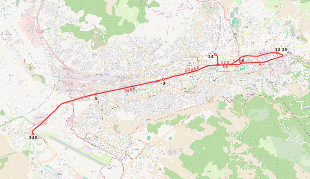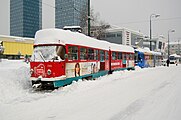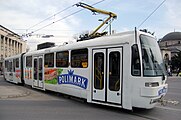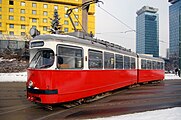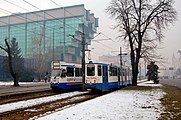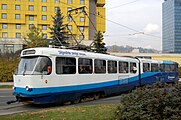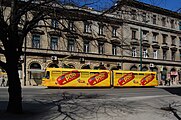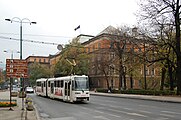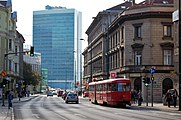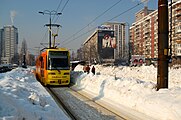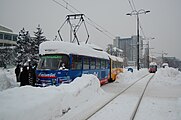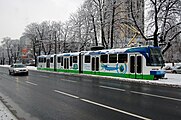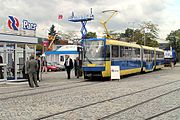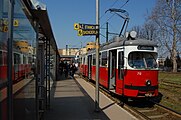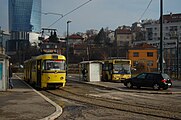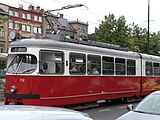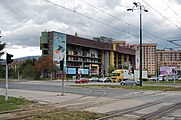Trams in Sarajevo
| Sarajevo tramway network | |||
|---|---|---|---|
 Sarajevo tram | |||
| Overview | |||
| Locale | |||
| Transit type | Tram | ||
| Number of lines | 6[1] | ||
| Number of stations | 28 | ||
| Website | gras | ||
| Operation | |||
| Began operation |
| ||
| Operator(s) | KJKP GRAS Sarajevo | ||
| Number of vehicles | 95[1] | ||
| Technical | |||
| Track gauge | 1,435 mm (4 ft 8+1⁄2 in) standard gauge | ||
| Old gauge | 760 mm (2 ft 5+15⁄16 in) Bosnian gauge until 1960 | ||
| |||
Trams in Sarajevo are a part of the public transport system in Sarajevo, the capital city of Bosnia and Herzegovina. The system is run by KJKP GRAS Sarajevo, which also operates trolleybus and bus routes in the city.
As of 2010, the Sarajevo tram system consists of seven lines,[1][2] running along a single route with a 0.4 kilometres (0.25 mi)-long branch to the city's main railway station (Željeznička Stanica). It primarily serves as an east-west link from the city centre (Baščaršija) to the western suburb of Ilidža.
History
[edit]
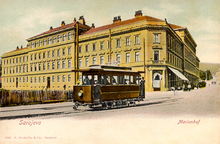
Opened on New Year's Day in 1885,[citation needed] the Sarajevo tramway was the testing line for the tram in Vienna and the Austro-Hungarian Empire, and operated by horses. Originally built to 760 mm (2 ft 5+15⁄16 in) Bosnian gauge, the present system was upgraded to 1,435 mm (4 ft 8+1⁄2 in) standard gauge in 1960. The trams played a pivotal role in the growth of the city in the 20th century.[3]
During the Siege of Sarajevo of 1992-1995, trackwork and numerous vehicles were badly damaged. The tram operation stopped on 15 April 1992, 9 days after the siege started, and resumed despite the dangers of the ongoing siege on 15 April 1994.[4] The vehicles are once again operational though marks remain on some vehicles.
System
[edit]Trams in Sarajevo | ||||||||||||||||||||||||||||||||||||||||||||||||||||||||||||||||||||||||||||||||||||||||||||||||||||||||||||||||||||||||||||||||||||||||||||||||||||||||||||||||||||||||||||||||||||||||||||||||||||||||||||||||||||||||||||||||||||||||||||||||||||||||||||||||||||||||||||||||||||||||||||||||
|---|---|---|---|---|---|---|---|---|---|---|---|---|---|---|---|---|---|---|---|---|---|---|---|---|---|---|---|---|---|---|---|---|---|---|---|---|---|---|---|---|---|---|---|---|---|---|---|---|---|---|---|---|---|---|---|---|---|---|---|---|---|---|---|---|---|---|---|---|---|---|---|---|---|---|---|---|---|---|---|---|---|---|---|---|---|---|---|---|---|---|---|---|---|---|---|---|---|---|---|---|---|---|---|---|---|---|---|---|---|---|---|---|---|---|---|---|---|---|---|---|---|---|---|---|---|---|---|---|---|---|---|---|---|---|---|---|---|---|---|---|---|---|---|---|---|---|---|---|---|---|---|---|---|---|---|---|---|---|---|---|---|---|---|---|---|---|---|---|---|---|---|---|---|---|---|---|---|---|---|---|---|---|---|---|---|---|---|---|---|---|---|---|---|---|---|---|---|---|---|---|---|---|---|---|---|---|---|---|---|---|---|---|---|---|---|---|---|---|---|---|---|---|---|---|---|---|---|---|---|---|---|---|---|---|---|---|---|---|---|---|---|---|---|---|---|---|---|---|---|---|---|---|---|---|---|---|---|---|---|---|---|---|---|---|---|---|---|---|---|---|---|---|---|---|---|---|---|---|---|---|---|---|---|---|---|---|---|---|
| ||||||||||||||||||||||||||||||||||||||||||||||||||||||||||||||||||||||||||||||||||||||||||||||||||||||||||||||||||||||||||||||||||||||||||||||||||||||||||||||||||||||||||||||||||||||||||||||||||||||||||||||||||||||||||||||||||||||||||||||||||||||||||||||||||||||||||||||||||||||||||||||||
The route lies on the main boulevard of Sarajevo, which is named (from west to east) first Bulevar Meše Selimovića (formerly 6 Proleterske Brigade), from Vila Čengić then Zmaj od Bosne (formerly Vojvode Radomira Putnika). From the district Marijin Dvor it runs a loop in a counter-clockwise direction along the Miljacka river on the street called Obala Kulina bana (formerly: Obala Vojvode Stepe Stepanovića). It proceeds to the terminus Baščaršija. The route then turns back towards Marijin Dvor on the northern parallel road Maršala Tita.
Seven routes are presently in operation on the system, often only a specific section of the track. Only Route 3 operates the entire length.
- Route 1: Željeznička stanica – Baščaršija
- Route 2: Čengić Vila – Baščaršija
- Route 3: Ilidža – Baščaršija
- Route 4: Ilidža – Željeznička stanica
- Route 5: Nedžarići – Baščaršija
- Route 6: Ilidža – Skenderija
- Route 7: Nedžarići – Skenderija
In the early 1990s, construction work started to expand the tram network from Nedžarići to Dobrinja, which was at the time served by a trolleybus system. Work stopped in 1992 when the siege started, which was also when most of the vehicles and infrastructure was damaged. At Nedžarići, it is possible to see tracks leading towards a planned, but never finished boulevard that would link towards Dobrinja. No work has been done in the said neighborhood to prepare access of trams there due to the start of the war, so these are the only traces of the planned extension.
Rolling stock
[edit]In 1958, Sarajevo bought 50 relatively modern PCC streetcars from Washington, renumbered in the 1-50 series. Another 21 more Washington PCCs followed in 1962, numbered 51-71. These 71 PCCs were built between 1941 and 1944 by the St. Louis Car Company. Between 1967 and 1969, 20 of these streetcars were reconstructed into ten articulated cars and renumbered 100-109.[citation needed]
The fleet in use on the network are Tatra K2 articulated trams from the Czech Republic, delivered in the 1970s and early 1980s. Later these trams were joined by more modern vehicles in recent times. In 2008, Amsterdam donated 16 old trams to Sarajevo.[citation needed]
In September 2021, Stadler was awarded a contract to supply 15 Tango NF3 trams to the city.[5] The first vehicle was unveiled at the 15th Trako International Railway Fair on 20 September 2023.[6] The first tram arrived in December 2023, while the rest are expected to arrive by the summer of 2024.[7] An additional 10 new trams were also bought.[8]
Gallery
[edit]-
Tram #009, May 19, 2024
-
Trams stopped running due to heavy snowfall, at Marijin Dvor on February 5, 2012
-
Tram #300 past Socijalno
-
Tram #602 past Park
-
Tram #511 at Holiday Inn
-
Tram #712 at Holiday Inn
-
Tram #707 past Univerzitet
-
Tram #506 at Vijećnica
-
Trams #805 and #812 at Socijalno
-
Tram #212 at Holiday Inn
-
Tram #508 running westbound at Marijin Dvor,
-
Tram #501 past Park
-
Tram #261 at Marijin Dvor,
-
Heavy snowfall on February 3, 2012
-
Satra III
-
Refurbished Tatra 3-carriage tram on display
-
Former Amsterdam tram
-
Satra II
-
Tram #713, Line #4, March 12, 2012
-
Tram #209, Line #3, March 16, 2012
-
Ilidža tram terminus with #713 ready for departure to the Railroad Station
-
Tram #501, Line #3, December 14, 2011
-
Tram #291, Line #1, December 18, 2011
-
Tram #505, Line #3, January 28, 2012
-
Tram #802, Line #3, January 5, 2012
-
Tram #277 leaving the tram depot, September 23, 2011
-
Tram #231, Line #1, September 24, 2011
-
Tram #710 Sarajevo (in 2010)
-
The remains of the planned extension to Dobrinja, in the background are the remains of the Sarajevo Retirement Home, which was very new at the time of the siege
-
Trams in Sarajevo map
-
Trams in Sarajevo map
-
The unofficial Sarajevo tram network map
See also
[edit]References
[edit]Footnotes
[edit]- ^ a b c d "Tramvaj" [Tramway] (in Bosnian). KJKP GRAS d.o.o. 2015. Archived from the original on 18 May 2015. Retrieved 13 May 2015.
- ^ "KJKP GRAS d.o.o." KJKP GRAS d.o.o. Retrieved 13 May 2015.
- ^ "Neven Anđelić: O mitu da je Sarajevo imalo prvi tramvaj u Evropi". Radio Sarajevo. 25 September 2010. Retrieved 20 November 2019.
- ^ "GRAS Sarajevo". Retrieved 8 January 2020.
- ^ "Sarajevo orders first new trams in decades". Railway Gazette International. 2 September 2021.
- ^ "New-build tram for Sarajevo unveiled". Railway Gazette International. 20 September 2023.
- ^ B.R. (14 December 2023). "U Sarajevo došao prvi od 15 novih tramvaja, nakon testiranja bit će pušten u redovan saobraćaj" (in Bosnian). Klix.ba. Retrieved 14 December 2023.
- ^ "Ministar Šteta objasnio kako će funkcionisati noćni javni prijevoz u Sarajevu". hocu.ba (in Bosnian). 25 December 2023. Retrieved 25 December 2023.
Bibliography
[edit]- Jan Čihák: Sarajevo Trams and Trolleybuses, ISBN 978-3-9503304-2-7, bahnmedien.at, Vienna/Austria

